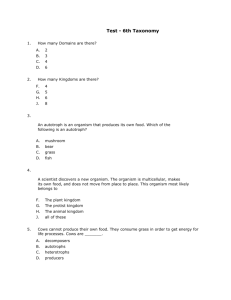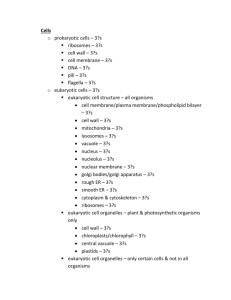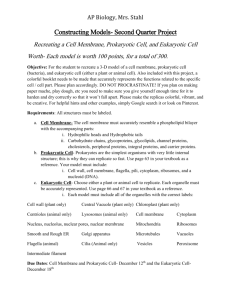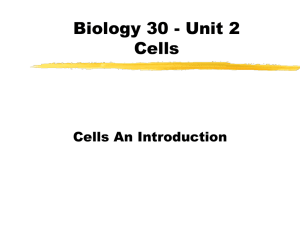1- INTRODUCTION CELLULAR ORGANIZATION: PROKARYOTIC
advertisement
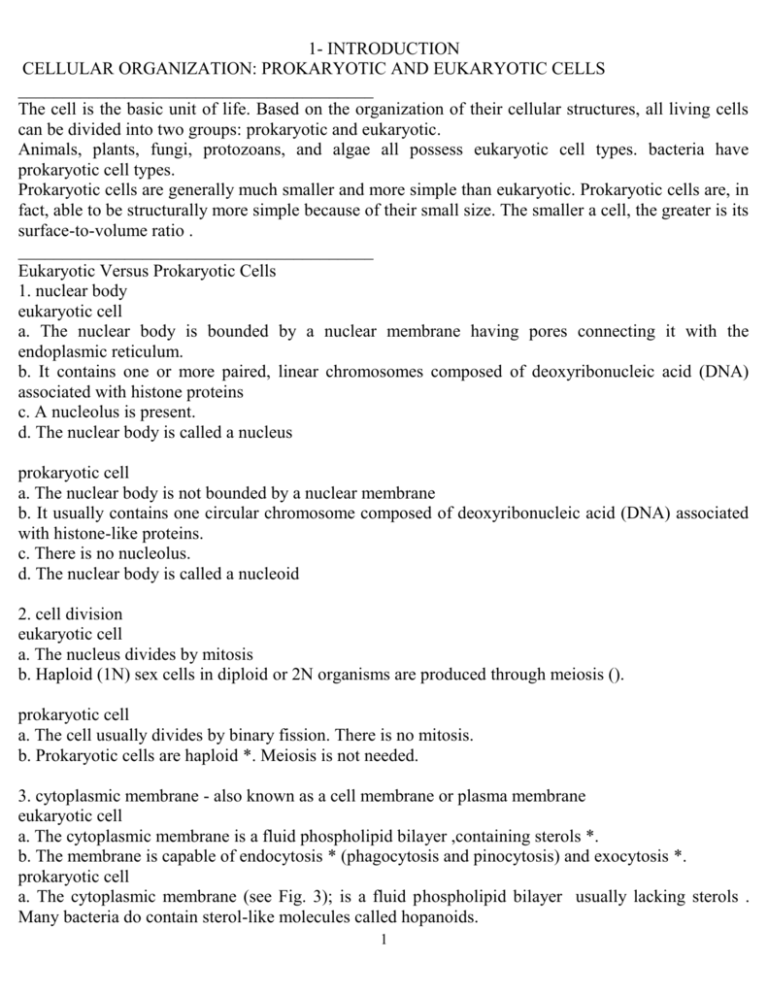
1- INTRODUCTION CELLULAR ORGANIZATION: PROKARYOTIC AND EUKARYOTIC CELLS ________________________________________ The cell is the basic unit of life. Based on the organization of their cellular structures, all living cells can be divided into two groups: prokaryotic and eukaryotic. Animals, plants, fungi, protozoans, and algae all possess eukaryotic cell types. bacteria have prokaryotic cell types. Prokaryotic cells are generally much smaller and more simple than eukaryotic. Prokaryotic cells are, in fact, able to be structurally more simple because of their small size. The smaller a cell, the greater is its surface-to-volume ratio . ________________________________________ Eukaryotic Versus Prokaryotic Cells 1. nuclear body eukaryotic cell a. The nuclear body is bounded by a nuclear membrane having pores connecting it with the endoplasmic reticulum. b. It contains one or more paired, linear chromosomes composed of deoxyribonucleic acid (DNA) associated with histone proteins c. A nucleolus is present. d. The nuclear body is called a nucleus prokaryotic cell a. The nuclear body is not bounded by a nuclear membrane b. It usually contains one circular chromosome composed of deoxyribonucleic acid (DNA) associated with histone-like proteins. c. There is no nucleolus. d. The nuclear body is called a nucleoid 2. cell division eukaryotic cell a. The nucleus divides by mitosis b. Haploid (1N) sex cells in diploid or 2N organisms are produced through meiosis (). prokaryotic cell a. The cell usually divides by binary fission. There is no mitosis. b. Prokaryotic cells are haploid *. Meiosis is not needed. 3. cytoplasmic membrane - also known as a cell membrane or plasma membrane eukaryotic cell a. The cytoplasmic membrane is a fluid phospholipid bilayer ,containing sterols *. b. The membrane is capable of endocytosis * (phagocytosis and pinocytosis) and exocytosis *. prokaryotic cell a. The cytoplasmic membrane (see Fig. 3); is a fluid phospholipid bilayer usually lacking sterols . Many bacteria do contain sterol-like molecules called hopanoids. 1 b.The membrane is incapable of endocytosis and exocytosis. 4. cytoplasmic structures eukaryotic cell a. The ribosomes * are composed of a 60S and a 40S subunit forming an 80S ribosome *. b. Internal membrane-bound organelles such as mitochondria *, endoplasmic reticulum *, Golgi apparatus * , vacuoles, and lysosomes * are present c. Chloroplasts * serve as organelles for photosynthesis. d. A mitotic spindle involved in mitosis is present during cell division. e. A cytoskeleton * is present. It contains microtubules, actin micofilaments, and intermediate filaments. These collectively play a role in giving shape to cells, allowing for cell movement, movement of organelles within the cell and endocytosis, and cell division. prokaryotic cell a. The ribosomes * are composed of a 50S and a 30S subunit forming an 70S ribosome *. b. Internal membrane-bound organelles such as mitochondria, endoplasmic reticulum, Golgi apparatus, vacuoles, and lysosomes are absent . b. There are no chloroplasts. Photosynthesis usually takes place in infoldings or extensions derived from the cytoplasmic membrane. c. There is no mitosis and no mitotic spindle. d. They may contains only actin-like proteins that, along with the cell wall, contribute to cell shape. 5. respiratory enzymes and electron transport chains eukaryotic cell - The electron transport system is located in the inner membrane of the mitochondria. prokaryotic cell - The electron transport system is located in the cytoplasmic membrane. 6. cell wall eukaryotic cell a. Plant cells, algae, and fungi have cell walls, usually composed of cellulose or chitin. Eukaryotic cell walls are never composed of peptidoglycan * . b. Animal cells and protozoans lack cell walls . prokaryotic cell a. With few exceptions, members of the domain Bacteria have cell walls composed of peptidoglycan . b. Members of the domain Archae have cell walls composed of protein, a complex carbohydrate, or unique molecules resembling but not the same as peptidoglycan. 7. locomotor organelles eukaryotic cell - Eukaryotic cells may have flagella or cilia. Flagella and cilia are organelles involved in locomotion and in eukaryotic cells consist of a distinct arrangement of sliding microtubules surrounded by a membrane. The microtubule arrangement is referred to as a 2X9+2 arrangement . prokaryotic cell . 2 CLASSIFICATION: THE THREE DOMAIN SYSTEM The Three Domain System, proposed by Woese and others, is an evolutionary model of classification based on differences in the sequences of nucleotides in the cell's ribosomal RNAs (rRNA), as well as the cell's membrane lipid structure and its sensitivity to antibiotics. Comparing rRNA structure is especially useful. Because rRNA molecules throughout nature carry out the same function, their structure changes very little over time. Therefore similarities and dissimilarities in rRNA nucleotide sequence are a good indication of how related or unrelated different cells and organisms are. This system proposes that a common ancestor cell gave rise to three different cell types, each representing a domain. The three domains are the Archaea (archaebacteria), the Bacteria (eubacteria), and the Eukarya (eukaryotes). The Eukarya are then divided into 4 kingdoms: Protists, Fungi, Anamalia, and Plantae. A description of the three domains follows: 1. The Archaea (archaebacteria) The Archaea possess the following characteristics: Archaea are prokaryotic cells. Unlike the Bacteria and the Eukarya, the Archaea have membranes composed of branched hydrocarbon chains attached to glycerol by ether linkages. The cell walls of Archaea contain no peptidoglycan. Archaea are not sensitive to some antibiotics that affect the Bacteria, but are sensitive to some antibiotics that affect the Eukarya. Archaea contain rRNA that is unique to the Archaea as indicated by the presence molecular regions distinctly different from the rRNA of Bacteria and Eukarya. Archaea often live in extreme environments and include methanogens, extreme halophiles, and hyperthermophiles. One reason for this is that the ether-containing linkages in the Archaea membranes is more stabile than the ester-containing linkages in the Bacteria and Eukarya and are better able to withstand higher temperatures and stronger acid concentrations. 2. The Bacteria (eubacteria) The Bacteria possess the following characteristics: Bacteria are prokaryotic cells. Like the Eukarya, they have membranes composed of unbranched fatty acid chains attached to glycerol by ester linkages . The cell walls of Bacteria, unlike the Archaea and the Eukarya, contain peptidoglycan. Bacteria are sensitive to traditional antibacterial antibiotics but are resistant to most antibiotics that affect Eukarya. Bacteria contain rRNA that is unique to the Bacteria as indicated by the presence molecular regions distinctly different from the rRNA of Archaea and Eukarya. 3 3. The Eukarya (eukaryotes) The Eukarya (also spelled Eucarya) possess the following characteristics: Eukarya have eukaryotic cells. Like the Bacteria, they have membranes composed of unbranched fatty acid chains attached to glycerol by ester linkages . Not all Eukarya possess cells with a cell wall, but for those Eukarya having a cell wall, that wall contains no peptidoglycan. Eukarya are resistant to traditional antibacterial antibiotics but are sensitive to most antibiotics that affect eukaryotic cells. Eukarya contain rRNA that is unique to the Eukarya as indicated by the presence molecular regions distinctly different from the rRNA of Archaea and Bacteria. The Eukarya are subdivided into the following kingdoms: a. Protista Kingdom Protista are simple, predominately unicellular eukaryotic organisms. Examples includes slime molds, euglenoids, algae, and protozoans. b. Fungi Kingdom Fungi are unicellular or multicellular organisms with eukaryotic cell types. The cells have cell walls but are not organized into tissues. They do not carry out photosynthesis and obtain nutrients through absorption. Examples include sac fungi, club fungi, yeasts, and molds. c. Plantae Kingdom Plants are multicellular organisms composed of eukaryotic cells. The cells are organized into tissues and have cell walls. They obtain nutrients by photosynthesis and absorption. Examples include mosses, ferns, conifers, and flowering plants. d. Animalia Kingdom Animals are multicellular organisms composed of eukaryotic cells. The cells are organized into tissues and lack cell walls. They do not carry out photosynthesis and obtain nutrients primarily by ingestion. Examples include sponges, worms, insects, and vertebrates. 4




